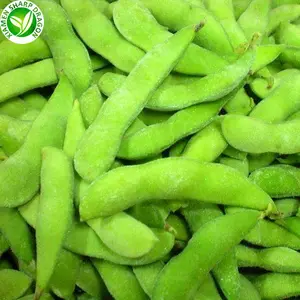
All categories
Featured selections
Trade Assurance
Buyer Central
Help Center
Get the app
Become a supplier

(2433 products available)













































edamame are a staple in the agricultural industry, providing consumers with convenient access to nutritious vegetables year-round. These products are harvested at their peak and quickly frozen to preserve their freshness and nutritional value. The freezing process ensures that the vegetables retain their color, texture, and flavor, making them a reliable option for those seeking quality produce regardless of seasonal availability. edamame are available in various forms, including whole, sliced, diced, and pureed, catering to diverse culinary needs and preferences.
When it comes to edamame, there is a wide array of options available to suit different tastes and dietary requirements. Common varieties include green peas, spinach, broccoli, carrots, and mixed vegetable blends. Each type of vegetable offers unique nutritional benefits, with green peas rich in protein and fiber, while spinach is renowned for its high iron content. Broccoli provides a good source of vitamins C and K, whereas carrots are known for their beta-carotene levels. Mixed vegetable blends offer a convenient way to enjoy a variety of nutrients in one serving. The diverse selection of edamame ensures there is something for everyone, whether you're preparing a simple side dish or a complex recipe.
edamame come with numerous advantages that make them a popular choice among consumers. One of the key benefits is their long shelf life, allowing them to be stored for extended periods without spoilage. This reduces food waste and ensures a consistent supply of vegetables, even during off-seasons. The quick-freezing process used in the preparation of edamame helps preserve essential vitamins and minerals, making them comparable to fresh produce in terms of nutritional value. Additionally, frozen vegetables are pre-washed and pre-cut, saving time and effort in meal preparation. They are perfect for busy individuals looking to maintain a healthy diet without sacrificing convenience.
The primary ingredient in edamame is, of course, the vegetable itself, which is often supplemented with minimal additives to maintain quality. These additives may include antioxidants such as ascorbic acid (vitamin C) to prevent discoloration and preserve freshness. The nutritional profile of edamame varies depending on the type of vegetable, but generally, they are low in calories and high in essential nutrients. For example, a serving of frozen spinach is rich in iron, calcium, and vitamins A and C, while frozen carrots provide a good source of beta-carotene and potassium. It is important to check the packaging for specific nutritional information, as this can vary between brands and products.
Utilizing edamame in cooking is straightforward and versatile, making them a valuable addition to any kitchen. They can be used in a wide range of dishes, from soups and stews to stir-fries and casseroles. To prepare edamame, simply follow the instructions on the packaging, which typically involve steaming, boiling, or microwaving. These methods help retain the vegetables' nutritional content and ensure optimal flavor. Frozen vegetables can also be added directly to recipes without prior thawing, making them ideal for quick meals. Experimenting with different combinations and cooking techniques allows for endless culinary possibilities, making edamame a staple for creative cooking.
When selecting edamame, there are several factors to consider to ensure you are choosing the best option for your culinary needs. First, examine the packaging for signs of damage or freezer burn, as these can indicate compromised quality. It's also essential to check the expiration date and ensure the vegetables are within their optimal usage period. Consider the vegetable variety and its intended use in your recipes; some vegetables, like spinach, are versatile and can be used in various dishes, while others, like broccoli, may be better suited for specific meals. Additionally, assess the amount of added ingredients, such as preservatives or sauces, which could affect the flavor and nutritional profile of the edamame.
Certifications and labels on edamame provide valuable information about the product's quality and sustainability. Organic certifications indicate that the vegetables were grown without synthetic pesticides or fertilizers, offering a more natural option. Look for labels that detail the vegetable's origin, as produce sourced from regions known for high-quality agriculture can be more reliable. Non-GMO labels assure that the vegetables have not been genetically modified, preserving their natural genetic makeup. Understanding these certifications helps consumers make informed choices regarding the health and environmental impact of the edamame.
Proper storage and handling of edamame are crucial to maintaining their quality and nutritional value. Frozen vegetables should be stored at a consistent temperature of 0°F (-18°C) to prevent thawing and refreezing, which can degrade their texture and taste. When handling edamame, avoid leaving them out at room temperature for extended periods, as this can lead to spoilage. For best results, use a vacuum-sealed container or a bag with a secure closure to minimize exposure to air and moisture. These practices ensure that the vegetables remain fresh and flavorful until they are ready to be used.
edamame that have been thawed and refrozen often exhibit visible signs such as ice crystals or a watery texture. The color may also appear duller, and the flavor can be less vibrant compared to properly frozen vegetables.
Yes, edamame retain much of their nutritional value due to the quick-freezing process that locks in vitamins and minerals. While some nutrients may degrade slightly, the overall nutritional profile is comparable to fresh vegetables.
While edamame are typically used in cooked dishes, they can be incorporated into raw dishes if properly thawed and drained. However, the texture may differ from fresh vegetables, so adjustments in preparation may be necessary.
Most edamame do not require preservatives because the freezing process itself acts as a natural preservative. However, some products may include minimal additives for flavor enhancement or color preservation.
The best way to cook edamame is by steaming, microwaving, or sautéing, as these methods help retain their nutritional content and flavor. Avoid boiling, which can lead to nutrient loss and a mushy texture.